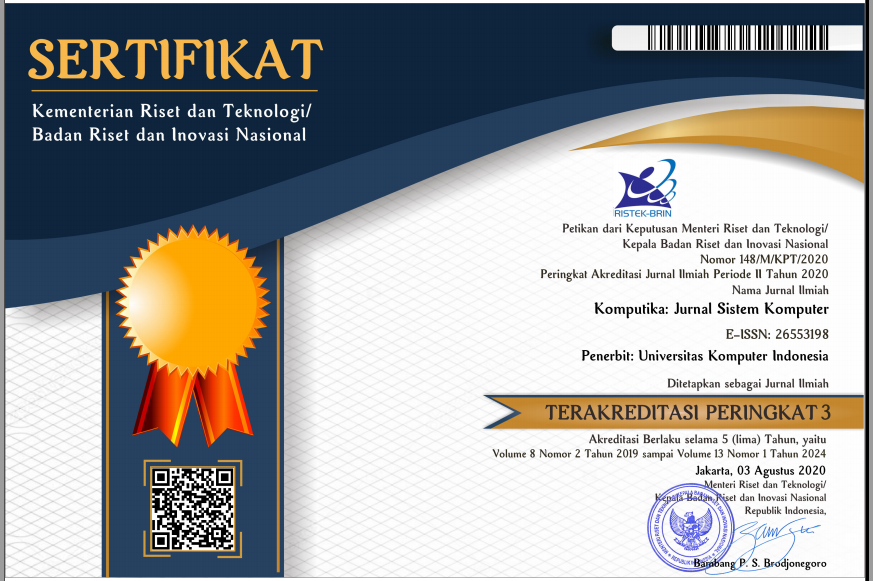Robot Panen Hidroponik Berbasis Human Following
DOI:
https://doi.org/10.34010/komputika.v12i1.9028Abstract
Modern agriculture is in great demand among modern farmers, especially in urban areas due to a large number of land conversions. Hydroponics is a popular farm because it does not require large land, minimal maintenance because it does not require regular fertilization, but produces a maximum harvest. Increasing yields requires a more efficient harvesting process, with robotic technology allowing us to make interactive harvest baskets, by making Human Following Robot. The robot is built using Arduino UNO microcontroller, there are 4 sensors to support the robot process to run well-ultrasonic sensors are used to detect obstacles so that the robot runs forward with a distance of > 40 and a distance of < 20. IR sensor is used for the process of detecting obstacles so that the robot can turn right and right, data from the sensor is sent to the microcontroller to be processed by the motor driver so that the robot's wheels can move according to the sensor data. To make it easier to find out how much the harvest weighs using a loadcell sensor and the HX711 sensor module changes from resistance to weight, sensor data will be sent to the microcontroller for processing to the 16x2 LCD to display the results of the weighing process.
Keywords - Human Following Robot, microcontroller, Ultrasonic, IR Sensor, Loadcell
References
R. Prabowo, aziz nur Bambang, and Sudarno, “Pertumbuhan Penduduk Dan Alih Fungsi Lahan Pertanian,” J. Ilmu-Ilmu Pertan., vol. 16, no. 2, pp. 26–36, 2020.
Badan Pusat Statistik Indonesia, “Welfare Indicators 2019: Infrastructure Development in Indonesia,” p. 270, 2019.
S. I. Kusumaningrum, “Pemanfaatan Sektor Pertanian Sebagai Penunjang Pertumbuhan Perekonomian Indonesia,” J. Transaksi, vol. 11, no. 1, pp. 80–89, 2019, [Online]. Available: http://ejournal.atmajaya.ac.id/index.php/transaksi/article/view/477.
P. Effendi, S. Muhammad, H. Rusman, and P. Y. Muhammad, Menuju Pertanian Modern Berkelanjutan. 2017.
H. Abbas, R. Syam, and B. Jaelani, “Rancang Bangun Sebagai Tempat Budidaya Tanaman Menggunakan Solar Cell Sebagai Sumber Listrik,” Proceeding Semin. Nas. Tah. Tek. Mesin, no. Snttm Xiv, pp. 7–8, 2015.
Y. Yusran, “Implementasi Jaringan Syaraf Tiruan (Jst) Untuk Memprediksi Hasil Nilai Un Menggunakan Metode Backpropagation,”Jurnal Iptek Terapan, 2016. DOI: 10.22216/jit.2015.v9i4.571
C. Brinkley and J. S. Kingsley, “Urban agriculture_Case Studies,” Adv. Agric. Anim. Welf. Sci. Pract., pp. 241–257, 2017.
I. S. Roidah, “Pemanfaatan Lahan Dengan Menggunakan Sistem Hidroponik,” Jurnal Bonorowo, vol. 1, no. 2, pp. 43–50, 2014.doi: https://doi.org/10.36563/bonorowo.v1i2.14
R. I. Athifa, A. Astuti, and A. S. Wibowo, “Analisis Ekonomi Usahatani Sayuran Oriental Dengan Sistem Hidroponik Nft Tanpa Naungan Greenhouse,” J. Agribisnis Terpadu, vol. 12, no. 1, p. 15, 2019, doi: 10.33512/jat.v12i1.5531.
T. B. Sheridan, “Human-Robot Interaction,” Hum. Factors, vol. 58, no. 4, pp. 525–532, 2016, doi: 10.1177/0018720816644364.
A. Basit, A. Sya’bani Putra, G. Ayu Revira, and R. Nur Widia, “Smart Door Lock Berbasis QR Code,” Smart Comp Jurnalnya Orang Pint. Komput., vol. 11, no. 1, pp. 5–8, 2022, doi: 10.30591/smartcomp.v11i1.3179.
R. S. Pressman, Software Quality Engineering: A Practitioner’s Approach Fifth Edition. 2015.
P. D. . Silitonga and D. E. R. Purba, “Implementasi System Development Life Cycle Pada Rancang Bangun Sistem,” J. Sist. Inf. Kaputama, vol. 5, no. 2, pp. 196–203, 2021.
M. S. Yoski and R. Mukhaiyar, “Prototipe Robot Pembersih Lantai Berbasis Mikrokontroller dengan Sensor Ultrasonik,” JTEIN J. Tek. Elektro Indones., vol. 1, no. 2, pp. 158–161, 2020, doi: 10.24036/jtein.v1i2.67.
V. Uba, Learn to Program in Arduino TM C : 2017.



















